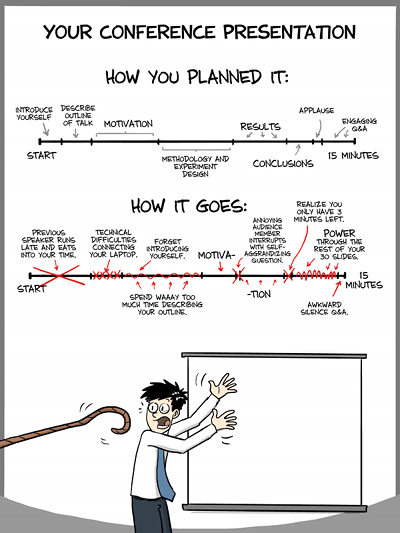A few days ago, a PHD Comics cartoon appeared on the Startup PH Facebook group:
While it’s not there anymore (possibly because it deals with academic conferences and not tech/startup conferences and therefore not relevant to the group), I had a voice at the back of my head nagging me to write a blog post on how the strip makes it look like speaking in conferences is a lot harder than it is.
So here’s a blog post on how to prepare yourself for the worst things that can happen when participate in a public speaking engagement.
Previous speaker runs late and eats into your time.
Not really a problem, as almost all of the events I’ve been in perform the laptop setup during the Q&A of the previous speaker. So even if the speaker runs late, it’s not going to eat into your allotted time.
Technical difficulties connecting your laptop.
In my experience, the biggest cause of technical difficulties in laptop setup are Macs. “They just work” my ass.
First off, they need special adapters for video. Your brand new MacBook Air is cool and all, but you’re pretty much screwed if you forgot to bring your mini-DP to VGA adapter.
Second is that non-frequent speakers don’t know how to change the display settings of their Mac to provide the optimal presentation experience. Unless you’re presenting in a Mac heavy venue, don’t expect the technical staff to help you with that.
I’m not saying that if you are using a laptop with a VGA connector, you’re out of the woods already. You still need to know how to change your monitor settings. You can even set your laptop display to 1024 x 768 even before connecting it to the projector to reduce the possibility of getting just a blank screen.
There’s also a plan B for all laptops: Export your presentation to PDF and/or upload it to an online presentation site (eg. SpeakerDeck, Slideshare, or Prezi if you’re feeling fancy). This way, even if your machine fails to connect to the projector, you can borrow another laptop and still be able to have your slides.
“But what about my presentation animations?” you may ask.
Screw animations. Go read Presentation Zen and educate yourself on why you don’t need them.
Forget introducing yourself.
Let me tell you a secret that you’ve probably forgotten once you got that invite to speak on stage:
Nobody gives a shit who you are.
Giving a long introduction about yourself at the beginning of the talk is stupid. For one, if it’s a big conference, you’ll probably have your bio on the programme. On the other hand, if it’s a small conference, you’ll probably be forgotten by the audience by the end of the day especially if you give a boring talk.
And if for some reason you’re a really big name in the field, why introduce yourself to people who already know all about you?
So don’t waste your time talking about who you are. Make a memorable talk and put your website/facebook/twitter/etc on the last slide and people will look you up themselves.
Spend waay too much time describing the outline.
Realize you have 3 minutes left.
Power through the rest of your 30 slides.
Let’s ignore for a moment that tech/startup conference talks don’t have motivation, methodologies and shit.
Anyway, timing problems can be easily be solved by having 2 things: practice and a timer.
Practice is obvious, but too often I see newbie speakers just wing it in front. When I do my talks, I immediately see in the first few practice runs what parts can eat up a lot of time and what parts allow me some time to ad lib. And the shorter and more time-constrained my talks are, the more practice runs I do – this way, I could consider all possibilities and think of backup plans far in advance of the talk.
The timer can be anything: the timer in your presentation software, a pocket watch, or a timer in your handheld clicker/presenter. Combined with practice, you will eventually know what time to expect to reach certain parts of your talk and all you need to do is to adjust accordingly.
Motiva – Annoying audience member interrupts with self-aggrandizing question – tion
You are the speaker. The audience has no control over you. In fact, you are in control of them.
If an annoying audience member (as opposed to good audience members that facilitate interaction and discussion) constantly interrupts your talk, it is your responsibility to put them in their place. It’s up to you whether you’ll humiliate them to shut them up or just tell them to talk to you directly after your presentation – point is, you don’t let them waste your time.
Awkward silence Q&A
Just expect this to happen. Out of the dozens of talks I’ve done these past few years, only about 1 in 10 had engaging Q&As, while only 1 in 3 even had questions for me.
—
Now that wasn’t so hard, was it?



